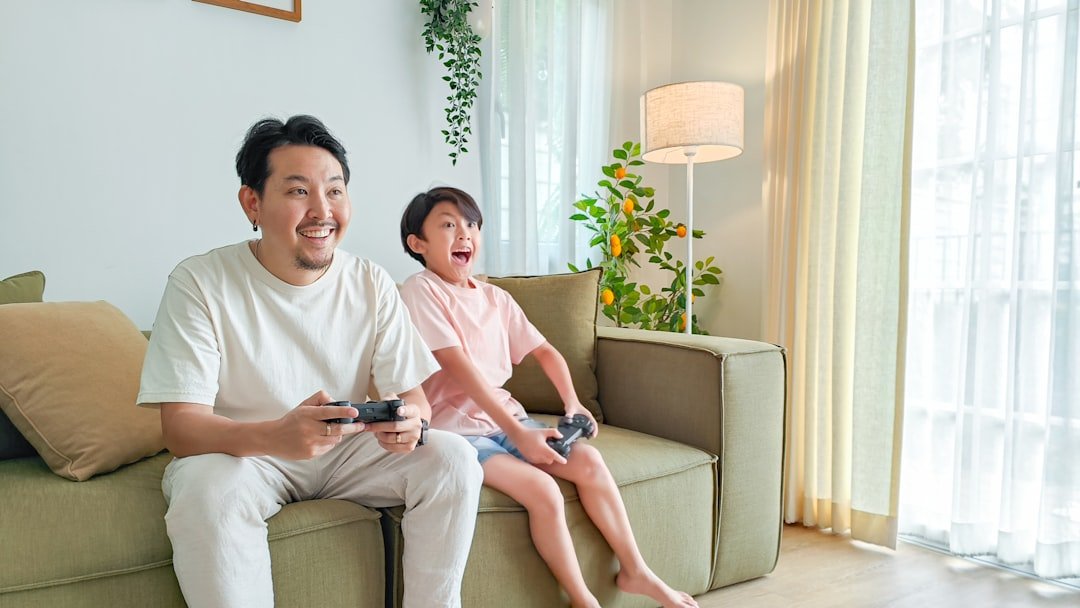Gaming has evolved dramatically since the days of the 1982 Commodore 64. The industry has grown so significantly that by 2021, over 65.1 million gaming products will be sold worldwide, including 27.9 million gaming notebooks and 17.5 million gaming desktops.
While gaming PCs and gaming laptops continue to advance with high-performance graphics cards and powerful processors, many parents still struggle to understand this digital playground. As a parent myself, I understand the concerns about online safety, screen time, and the impact of games on our children’s development.
In this comprehensive guide, we’ll explore what modern gaming means in 2025, its effects on child development, and practical strategies for setting healthy boundaries. I’ll help you navigate the gaming landscape with confidence, ensuring your children can enjoy the benefits while staying safe.
Understanding Modern Gaming in 2025
The gaming landscape has fundamentally shifted from a niche hobby to a mainstream entertainment powerhouse. Research shows that 68.7% of consumers play video games regularly, with over a third engaging daily.
What defines gaming today
Modern gaming transcends age and gender boundaries. The average gamer is now 36 years old, shattering previous stereotypes. Furthermore, women constitute nearly 46% of the gaming population. Players now demand high-quality graphics, immersive storytelling, and innovative gameplay mechanics across all platforms.
Popular gaming platforms
Today’s gaming platforms offer diverse experiences for every type of player. Here’s how players currently distribute across different platforms:
- 69.0% choose mobile devices
- 48.8% prefer gaming consoles
- 32.2% opt for PC gaming
Additionally, the global gaming industry has reached an impressive USD 200.00 billion in value, demonstrating its massive economic impact.
The rise of cloud gaming
Cloud gaming represents a major shift in how we access and play games. Services like Xbox Cloud Gaming and NVIDIA GeForce NOW enable players to stream their games over the internet without requiring powerful hardware. Moreover, cloud gaming requires internet speeds between 5Mbps to 20Mbps for optimal performance.
The technology notably reduces reliance on physical devices, allowing gamers to maintain their purchased games permanently without frequent updates. Cross-platform compatibility has become increasingly important, with services working across smart TVs, phones, and non-gaming laptops.
Gaming’s Impact on Child Development
Recent research reveals fascinating insights about gaming’s influence on young minds. A groundbreaking NIH study found that children who played video games for three hours daily showed superior cognitive performance compared to non-gamers.
Cognitive benefits
When designed thoughtfully, games can enhance multiple aspects of mental development. Children who engage in gaming demonstrate better impulse control and working memory. These improvements aren’t just theoretical – brain imaging shows increased activity in regions associated with attention and memory among young gamers.
The cognitive advantages of gaming include:
- Enhanced visual perception and information processing
- Improved ability to switch between tasks efficiently
- Better problem-solving and strategic thinking skills
Social skills development
Although many assume gaming leads to isolation, research paints a more nuanced picture. UNICEF’s research indicates that well-designed games can help children develop crucial social connections and emotional regulation skills. Particularly through collaborative gaming, children learn to manage social relationships and express themselves effectively.
Despite these benefits, balance remains crucial. Studies indicate that excessive gaming (beyond 20 hours weekly) can lead to decreased social interactions and potentially weaker social skills. Nevertheless, multiplayer games often serve as a social lifeline for children who struggle with peer connections, offering them a unique platform to develop friendships through shared interests.
The social impact varies based on how games are used. Children playing collaborative social games often demonstrate more prosocial behaviors, helping others both online and in real-world settings. Essentially, gaming can create a safe space for children to practice social skills, especially during times when face-to-face interactions might be limited.
Setting Healthy Gaming Boundaries
Setting boundaries around gaming requires a thoughtful approach that considers both age and individual needs. The American Academy of Pediatrics recommends specific time limits that serve as an excellent starting point for parents.
Age-appropriate time limits
Children of different ages need distinct gaming limits. For young children under 6, screen time should be limited to less than one hour daily. Subsequently, children aged 6-12 should have no more than two hours of gaming time. Accordingly, teens require more nuanced limits, primarily focusing on maintaining balance with other activities.
Creating a balanced schedule
A well-structured gaming schedule starts with clear priorities. Make gaming time contingent on completing homework and chores. One effective approach involves allowing 30 minutes of gaming on weekdays and one hour per day on weekends.
To maintain balance, consider these proven strategies:
- Schedule gaming in communal areas, not bedrooms
- Stop gaming at least one hour before bedtime
- Set measurable goals for long-term assignments
Using parental controls effectively
Modern gaming platforms offer robust parental control options. The Xbox Family Settings app enables activity reports and time limits across devices. Consequently, PlayStation systems provide comprehensive management tools, including spending limits and friend approvals. Nintendo Switch stands out with its user-friendly smartphone app that can automatically suspend games when time limits are reached.
For specific games, platforms like Epic Games offer “cabined accounts” that restrict in-game purchases and monitor activity. Therefore, Roblox provides age-appropriate ‘safe chat’ modes and curated game lists. These controls should function as training wheels, giving structure as children mature and learn responsible gaming habits.
Common Gaming Concerns Addressed
Parents often express valid concerns about their children’s gaming habits. Rather than dismissing these worries, let’s examine the key issues that need attention.
Online safety risks
Online gaming spaces present risks similar to those of other digital environments. Identity theft and account takeovers have become increasingly common, primarily through chat functions where criminals gather sensitive information. Malware and viruses pose another significant threat, often disguised as free game downloads or cheat codes.
The first thing to remember is that cyberbullying remains a persistent issue in gaming communities. Indeed, research shows that toxic behavior and harassment particularly affect female gamers. To combat these risks, keeping gaming devices in public spaces allows for better monitoring of online interactions.
Gaming addiction signs
The World Health Organization officially recognized Gaming Disorder as a mental health condition. Studies indicate that approximately 15% of gamers face compulsive gaming issues, with up to 4% becoming pathologically addicted. Key warning signs include:
- Unsuccessful attempts to reduce playing time
- Preoccupation with games when not playing
- Declining academic performance or hygiene
- Using games to escape real-life problems
- Experiencing withdrawal symptoms like anxiety or irritability
Violence in games
As opposed to common assumptions, the relationship between gaming violence and real-world behavior remains complex. Overall, research from Harvard Medical School suggests that violent content affects different children differently, with personality traits playing a crucial role. Generally, studies show that aggressive behavior may increase in some children after exposure to violent games.
To address these concerns, experts recommend monitoring game content ratings, discussing in-game situations with children, and redirecting to age-appropriate games when necessary. Parents should treat gaming spaces as they would physical spaces – considering age-appropriate supervision and establishing clear boundaries for interaction.
Conclusion
Gaming has become an integral part of modern life, offering both opportunities and challenges for parents and children alike. Through my research and personal experience, I’ve seen how gaming can enhance cognitive abilities, build social connections, and develop problem-solving skills when managed properly.
Parents who understand gaming’s role can make better decisions about their children’s digital activities. Setting age-appropriate boundaries, using parental controls, and maintaining open communication about online safety create a foundation for healthy gaming habits. These steps help children enjoy gaming’s benefits while avoiding potential risks like addiction or exposure to inappropriate content.
Rather than viewing gaming as a threat, consider it a tool for growth and development. Children who game responsibly often show improved memory, better multitasking abilities, and stronger social bonds with peers. Still, success depends on active parental involvement and consistent enforcement of established guidelines.
Remember that each child responds differently to gaming. Watch for warning signs of excessive use, stay informed about the games your children play, and adjust boundaries as needed. Most importantly, keep conversations about gaming open and honest with your children, ensuring they feel comfortable sharing their experiences and concerns with you.








Leave a Reply